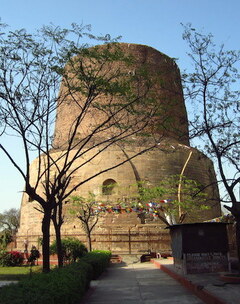In Praise of Vārāṇasī
In Praise of Vārāṇasī, the Supreme Place
by Jamyang Khyentse Chökyi Lodrö
Oṃ svasti!
In this unique source of many hundred forms of auspiciousness,
Site of the auspicious first turning of the Dharma Wheel,
Great forest grove, home to auspicious deer,
May the auspicious Great Sage grant auspiciousness!
Like an enchanted city of immortal gods
Transposed directly from the heavens,
Its splendid name, Ṛṣipatana — 'Sages' Descent' —
Nectar to the ears of all, past, present and future.
Here the supreme Sage, with the splendour of a hundred suns,
Eclipsed the light of every other being in the world,
And all were compelled to shut their eyes simultaneously,
As the brilliance of virtue and goodness shone!
Upon the great adamantine throne of the Vajra Seat,
You sat unmovingly in a single cross-legged posture,
And having reached the essence of enlightenment,
Wended your way here — thus, may there be virtue!
Here it was that your very first followers gathered,
The five excellent disciples, intoxicated with pride,
Who had scolded you and sworn an oath.
But, like dry grass suddenly set aflame,
They instantly arranged a seat of the finest materials
When they saw you, the sublime leader of men, approach.
And, like great vines falling to the earth,
Prostrated themselves in reverence and faith.
Then, with the light of compassion, you, a lion among men,
Summoned Indra and Prajāpati (Brahmā),
Who arrived with a majestic, melodious sound
And a blazing thousand-spoked wheel of gold.
They urged you to turn the sacred Dharma Wheel,
And, upon a throne supported by lions,[1]
You sounded your fearless roar
Of threefold formulation.[2]
You turned the precious wheel, unknown in former ages,
In unsurpassable ways, heard up to the very summit of existence,
And eighty thousand deva sons and daughters saw the truth,
As your renown extended unto existence's peak.
Thus, in this supremely noble, sacred place,
You performed the greatest of all a buddha's deeds,
The resonant speech-activity of a supreme nirmāṇakāya,
To rouse beings from the slumber of twofold ignorance.
Fragrantly scented trees are to be found here in abundance,
And precious hills, rocky shelters and grassy plains,
All laid out like a maṇḍala of turquoise meadows,
Where flowers, red and white, vie with one another.
Pools of bathing water possess the eight qualities,
Fine houses gleam as if made from lunar crystal,
And in the surface of the glittering marble[3]
Reflections appear and are clearly seen.
Deer with magnificent coats graze and play,
Heavenly birds call out in sweet, beguiling songs,
Streams bubble and splash as they flow along,
And gods and sages dwell.
There are traces of the excellent deeds
Of the great dharma-king Aśoka,
Which are enough to stir the mind
With faith and disenchantment.
Here too, amid many signs of degeneration,
The one known as Dharmapāla of Ceylon,[4]
An illustrious king of Dharma, restored the place,
As if encouraging a patient to rise from bed.
In a great casket of jewels and refined gold,
Upon heaps of water crystal supported by a lotus,
The precious relics, shining white and black,
Of the supreme Kinsman of the Sun, Lord of Sages, were placed.
This is a place revered by all, including the gods;
It is a field for amassing boundless stores of merit,
And a supremely sacred site, whose true value
Exceeds even a cascade of wish-granting gems.
What is more, great treasures lie beneath the earth,
Compositions of the learned and accomplished
All arranged in garlands ready to burst forth,
Truly bringing liberation upon sight.
May this place, where support and supported alike are sacred,
Never decline but remain forever indestructible as a vajra
For as long as the teachings themselves continue to abide,
So that the light of virtue and auspiciousness grows ever brighter!
Thus, the one called Tsuklak Lungrik Nyima Mawé Sengé (Chökyi Lodrö) wrote this while in this very place. May virtue abound!
| Translated by Adam Pearcey (with the generous support of the Khyentse Foundation and the kind assistance of Alak Zenkar Rinpoche), 2018.
Bibliography
Tibetan Edition
'jam dbyangs chos kyi blo gros. "gnas mchog wa rAN sIr bstod pa/" in ’jam dbyangs chos kyi blo gros kyi gsung ’bum. 12 vols. Bir: Khyentse Labrang, 2012. W1KG12986 Vol. 10: 353–356
Version: 1.2-20210714
-
Literally "five-faced lions". There are different explanations as to why lions are called "five-faced" (gdong lnga ldan); according to one, it is because they are capable of crushing and tearing apart other animals, such as elephants, with their four limbs and their mouths, as if they had five sets of jaws. ↩
-
The threefold formulation (bzlas pa gsum) relates to the three paths of seeing, meditation and no-more learning. In the first, suffering, its origin, the path and cessation are understood. In the second, suffering is to be known, the origin to be abandoned, the path to be relied upon and cessation to be actualized. In the third, suffering is known, the origin abandoned, the path relied upon and cessation actualized. ↩
-
Tib. a mo ni rka ↩
-
Seemingly a reference to Anagārika Dharmapāla, founder of the Maha Bodhi Society. ↩
